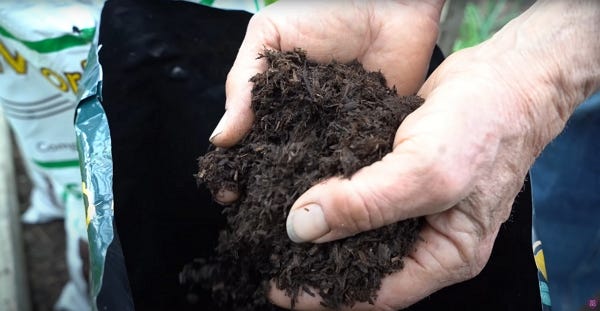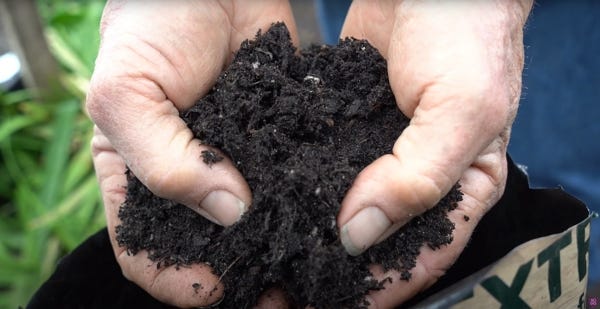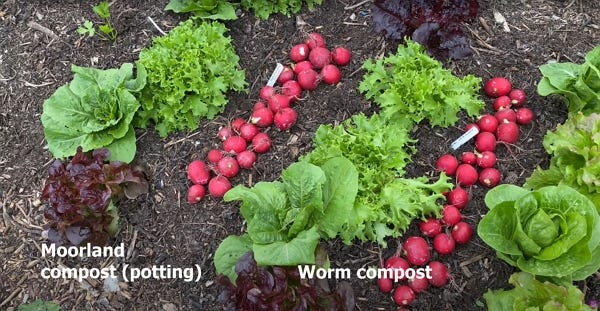Comparing different composts for propagation, by Charles Dowding
Experimenting brings surprises. Charles has been practicing for decades and here, he shares with us how compost can make a difference.
Thanks to Charles Dowding for sharing his wisdom and knowledge! I wrote the following notes watching the video published on Charles Dowding’s channel. You can watch it using this YouTube link.
The five composts of the trial
Homemade compost that is 8–10 months old
Purchased compost from a company called Moorland Gold in Yorkshire, UK, and there are two types: one for seeds, one for potting and container
Some gifted compost from digestion of plant fibers to produce methane for propagation (I didn’t quite catch the name of the brand...). The compost of the byproduct of digestion.
Some gifted New Horizon compost
Worm compost
Method used for the trial
Charles used 15-module trays.
I will review the vlogs from Charles about the trays later.
If you can wait, watch them now:
What is grown in the trial
Charles is doing the trial using radish and lettuce (batavia type).
Filling the trays
Don’t be afraid to fill them pretty full, e.g., pressing the compost into the modules so it is dense.
Why? Because the modules are small.
Watering
The initial watering needs to make the trays fully moist.
But after that, you don’t need to water daily. A rule would be to water enough so the compost stays humid.
The seedlings will require more watering later, as the seedlings grow.
When will the seedlings be ready for transplanting
Radish will be ready first, about 2–3 weeks after sowing them in the trays.
Lettuce will need another week.
Week 1 updates
Charles received some worm compost so he prepared 2 trays:
one with this worm compost
one with the Yorkshire compost to be able to make a proper comparison.
As for the other trays, the progress is already quite significant:
Homemade compost
Moorland Gold compost
Digested compost
New Horizon compost
The take-out
Not much difference between the Yorkshire digested and New Horizon compost
The homemade compost isn’t totally successful, probably caused by too much woody material, according to Charles humble opinion. Maybe it is too young.
Week 3 updates
Moorland compost vs. worm compost
After 11 days, the Moorland compost has a small advantage.
But both trays show that the radishes are ready to transplant!
The trial
Homemade compost
Moorland Gold compost
Digested compost
New Horizon compost
The take-out
The homemade compost is caught up, but Charles is not sure what happened to the middle row of radishes, maybe some lack of water.
The digested compost indeed doesn’t look to have progressed as much and the color isn’t as green as the rest.
The Moorland Gold compost give out bigger seedlings, while the New Horizon shows more green plants.
Week 8 updates
Five weeks after transplanting in the bed, here are the results:
The radishes
Here are the pictures of the harvest, compost by compost:
Homemade compost
Moorland Gold compost
Digested compost
New Horizon compost
Worm compost vs. Moorland Gold potting compost
The take-out
The worm compost shows less slug damage than the others.
The Moorland Gold compost is good, followed by the New Horizon compost!
The homemade compost produced less, probably caused by the initial slow growth of a row of radishes.
The lettuces
The take-out
The homemade compost produced much better for the lettuces than the radishes, even if the seedlings weren’t looking as big as for the other composts.
Conclusion
All compost did pretty well, overall.
We can see some differences, with some lettuces lost (not due to compost but more from the seedling used).
Also, remember that the soil of Charles’s garden is quite rich and fertile. I wonder how in proportion he uses his homemade compost versus the Moorland Gold he buys.
Generic notes
When to prick lettuce seedlings into modules
Usually, it should be done when it is at the 2-leaf stage.
How long can we use purchased compost
A compost purchased is good for the year of purchased and the following, from Charles’s experience.
Sowing compost vs. potting compost
The usual difference between sowing compost and potting compost is that the seed compost usually has some sand in it for better draining.
Do you really need sowing compost for seedlings
According to Charles’s experience, it doesn’t make a big difference, apart from the price...
⏬⏬⏬


























